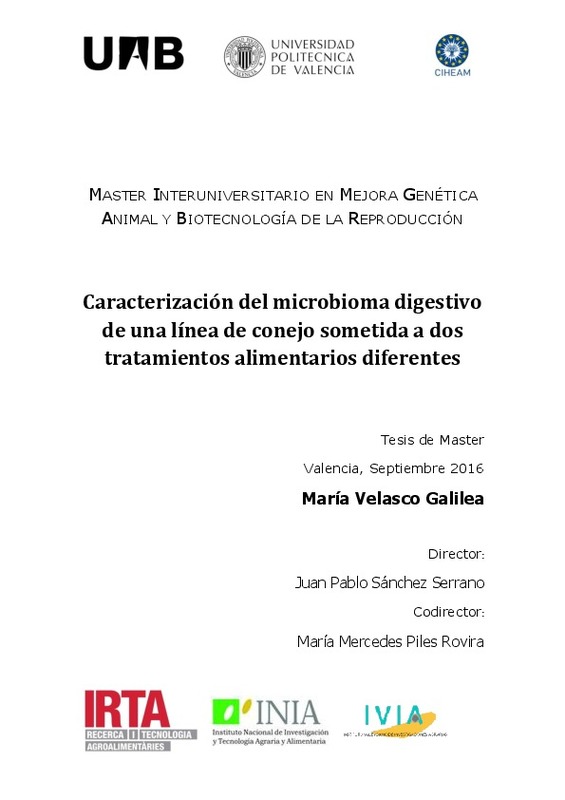|
Resumen:
|
[EN] Feed restriction during the fattening period is a widespread method of management
that is favorable for animal health because it reduces the risk of digestive problems
such as mucoid ...[+]
[EN] Feed restriction during the fattening period is a widespread method of management
that is favorable for animal health because it reduces the risk of digestive problems
such as mucoid enteropathy. Although feed
restriction penalizes animal growth, it
improves feed efficiency and reduces environmental impact, feeding costs and the use
of antibiotics. Feeding restriction modifies gastrointestinal bacterial fermentation
pattern and therefore it could change the micr
obial composition and activity. The aim
of this thesis is the characterization of caecal and faecal microbial communities that
belong to two groups of meat rabbits which were fed with different intake levels
during the fatting period, as well as to study t
he existence of possible associations of
some microorganisms with growth. Total DNA from caecum and faeces
–
belonging t 24
Caldes line rabbits; 11 fed
ad libitum
and 13 under restriction
-
was extracted with a
bead
-
beating kit. A 411 bases fragment correspo
nding to the hypervariable regions V4
and V5 of the 16S rRNA gene was amplified. Libraries of the 48 samples were
generated following manufacturer’s instructions of kit Nextera® XT and then
sequenced in parallel in a MiSeq Illumina sequencer. Readings gene
rated were
analyzed with the bioinformatic package QIIME yielding a table that includes the
normalized abundances of 1.823 OTUs. A linear model was implemented to study the
effects of feeding treatment, the origin of the sample and the interaction of both
on
the relative abundance of bacteria at different taxonomic levels: OTU, family and
phylum. A principal coordinate analysis (PCoA) was performed from weighted Unifrac
phylogenetic distance matrix. A linear model was also used to study the effect of
microb
ial composition on average daily gain (ADG) and weight at 31 days of life (P31).
Finally, the effect of microbial diversity on ADG was studied with a linear model in
which the explanatory factors were the feeding treatment and the regression on
number of o
bserved OTUs. The sequencing process generated 5.820.828 readings with
large variability between samples (range=40.025
-
240.333) which after filtering yielded
2.195.158 contigs. Rarefaction curves obtained for diversity index showed no
difference between th
e levels of the combination feeding treatment
-
origin of the
sample. This analysis detected four samples clearly separated from the rest. The
taxonomic characterization of the samples revealed that the dominant phyla were
Firmicutes
(76,31%),
Bacteroidetes
(7,61%) and
Tenericutes
(7,52%); last one hadn’t
been described in the literature before. A unique genus of the kingdom
Archaea
(
Methanobrevibacter
) was presented (0,65‰). Although the PCoA analysis did not
show a clear pattern of separation between sample
s depending on the combination of
feeding treatment
-
origin; when the effect of the origin of the sample on the microbial
composition was analyzed, significant differences were found for phyla
Actinobacteria
and
Cyanobacteria
; for families
Lachnospiraceae
,
Clostridiaceae
,
Coriobacteriaceae
, an
unknown family belonging to phylum
Proteobacteria
and an unknown family belonging
to orde
r
YS2
(
Cyanobacteria
). When the effect of feeding regimen on the microbial
composition was studied, significant differences were
found for phyla
Cyanobacteria
and
Tenericutes
; for an unknown family belonging to order
YS2
and for an unknown
xv
family belonging to order
RF39
(
Tenericutes
). PCoA showed that four atypical samples
had a microbial composition different from the rest and evid
enced significant
differences for 6 phyla and 27 families. In addition, 9 OTU
-
classified within families
Ruminococcaceae
and
Lachnospiraceae
from phylum
Firmicutes
-
were exclusive of
them. Although the microbial composition of these 4 samples is not typic
al of animals
affected by enteropathy, one of them was diagnosed with enteric problems during the
fattening period. The association study between microbial composition and average
daily gain, showed a negative association for the family
Mogibacteriaceae
(o
rder
Clostridiales
) and a positive association for one OTU of unknown family belonging to
the order
Clostridiales
. The study of association between ADG and the number of
observed OTUs was only significant for the group of animals fed under restriction
show
ing a positive association between diversity and ADG.
This study has tuned up
MiSeq sequence technology for the study of microbial composition of caecal and faecal
rabbit samples, we have also developed a pipeline based on the software QIIME. These
achieve
ments have allowed a preliminary study of the effect of feeding treatment and
the origin of the samples on the microbial composition and its influence on g
[-]
[ES] Se pretenden determinar las diferencias en las poblaciones microbianas del aparato
digestivo de una línea paternal de conejos sometida a dos regímenes de alimentación
(a voluntad o restringida). Se considerarán ...[+]
[ES] Se pretenden determinar las diferencias en las poblaciones microbianas del aparato
digestivo de una línea paternal de conejos sometida a dos regímenes de alimentación
(a voluntad o restringida). Se considerarán muestras tanto del contenido cecal como
de las heces, teniendo como objetivo aplicado la tesis el poder decidir qué tipo de
muestra ofrece una información más valiosa para caracterizar las diferencias entre los
tratamientos. De igual manera se trataría de asociar los distintos patrones
microbiológicos encontrados con el crecimiento y la mortalidad de los animales.
[-]
|






